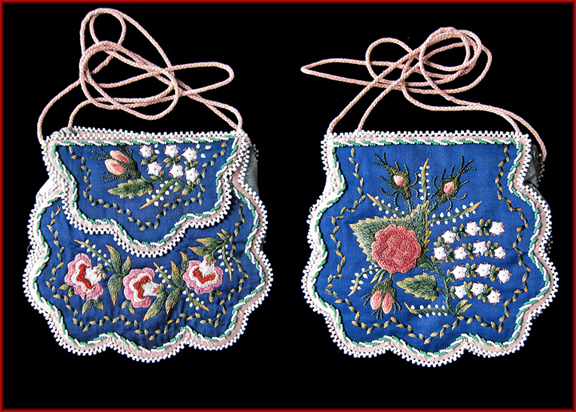Some of the rarest souvenir bags are decorated with dyed moosehair. From the testimony of the Indian themselves, moosehair embroidery has been in use since the earliest times to decorate their clothing (Speck 1911:1). This particular mid-nineteenth century example has the moosehair sewn onto a fine blue silk.
In souvenir work, moosehair embroidery was most often used to decorate objects made from birch bark, such as card cases, cheroot cases, canoe models and a host of other items. It was also used to decorate hats, moccasins, slippers and purses. The softer colors the Indians used to stain moose hair were derived from various sources, including berries, mosses and bark. It wasn’t until trade cloth became available that they were able to achieve brighter colors. They did this by boiling scraps of blue or red wool broadcloth along with the moosehair, leaching out their color, which gave the hair a vivid hue. In the mid-1850s, aniline dyes were industrialized and the synthetic dye industry began producing vivid colors that had a much broader range than were available with the natural dyes.
Though the use of moosehair to decorate articles made from birch bark is often associated with the work of the Ursuline nuns and their Huron students, the technique of moosehair embroidery has been found, with remarkable continuity, among the tribes from Alaska to the Great Lakes, as well as with the Iroquois and Algonkians (Speck 1911:1). Arthur C. Parker wrote that some of the finest Seneca textiles produced for what would ultimately be the state museum in Albany included rare embroideries in dyed moosehair that were made by Caroline Parker and her mother Elizabeth (Parker 1919:88).
Bags that were decorated with moosehair are scarce, and they are arguably the most exceptional form of souvenir bag.
References:
Speck, Frank
1911 - Huron Moosehair Embroidery in the American Anthropologist, Vol. 13.
Parker, Arthur C.
1919 - The Life of General Ely S. Parker, Last Grand Sachem of the Iroquois and General Grant’s Military Secretary. Published by the Buffalo Historical Society, Buffalo, New York.
